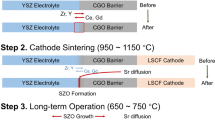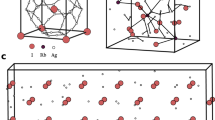Abstract
SOLID oxide electrolytes with predominantly oxide ion (O2−) conductivity should show isotope effects resulting from the different mobilities of 16O, 17O and 18O through the anion sub-lattice. In particular, the oxygen-containing gas stream leaving the cathode of an oxide electrolyte cell should be enriched in the heavier isotopes because of the greater mass and consequent lower mobility of 17O and 18O. This principle has already been suggested as a means of separating the heavier isotopes1 and we now describe experiments which were undertaken to examine the magnitude of its effect.
This is a preview of subscription content, access via your institution
Access options
Subscribe to this journal
Receive 51 print issues and online access
$199.00 per year
only $3.90 per issue
Buy this article
- Purchase on SpringerLink
- Instant access to full article PDF
Prices may be subject to local taxes which are calculated during checkout
Similar content being viewed by others
References
Tannenberger, H., and Schachner, H., Swiss Patent No. 428, 671 (January 31, 1967).
Spacil, H. S., and Tedmon, jun., C. S., J. Electrochem. Soc. (in the press).
Kirshenbaum, I., Physical Properties and Analysis of Heavy Water, 242 (McGraw-Hill, New York, 1951).
Kirshenbaum, I., Physical Properties and Analysis of Heavy Water, 243 (McGraw-Hill, New York, 1951).
Johnston, H. L., J. Amer. Chem. Soc., 57, 484 (1935).
Selwood, P. W., Taylor, H. S., Hipple, jun., J. A., and Bleakney, W., J. Amer. Chem. Soc., 57, 642 (1935).
Epstein, S., and Mayeda, T., Geochim. Cosmochim. Acta, 4, 213 (1953).
Author information
Authors and Affiliations
Rights and permissions
About this article
Cite this article
SPACIL, H., TEDMON, C. Oxygen Isotope Separation in Zirconia Electrolyte Cells. Nature 222, 662–663 (1969). https://doi.org/10.1038/222662a0
Received:
Issue date:
DOI: https://doi.org/10.1038/222662a0



